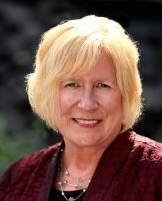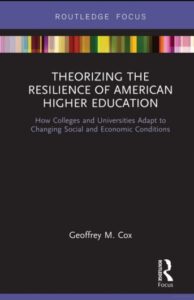 Reflections of Higher Education in a Time of Crisis: A Book Review
Reflections of Higher Education in a Time of Crisis: A Book Review
Dr. Irene Kovala
Former President
Glendale Community College (Glendale, Arizona)
Theorizing the Resilience of American Higher Education, 2019, by Geoffrey M. Cox, Ph.D.
Overview
In his opening prelude, Cox offers guidance to leaders of higher education institutions experiencing tumultuous times when he writes, “higher education has been remarkably adept at changing with the times, and there is no reason to think this capacity has been lost.” That wisdom of that reflection is abundantly apropos in a time when colleges and universities face unprecedented and extraordinary challenges. With Cox’s analysis and insight, we gain lessons that serve leaders well in the 21st Century.
New Purposes, New Models, New Revenues
 His book, segmented in two parts, provides both a chronology of the history of higher education and memorializes the seismic shifts higher education has made to adapt, react and reflect the changing American educational landscape. In Part I, Cox describes the three stimuli that have prompted higher education’s transformation through the ages: new social demands, availability of capital and emergence of new organizational models. The historic events of the Civil War, the Morrill Act, the GI bill and others were, each in their own time, the impetus for dramatic change. The movement to Land Grant universities, as an example, gave way to democratizing higher education by incorporating “mechanics” into the curricula that heretofore had been solely focused on the liberal arts. Cox notes, the agility of institutions to absorb, respond, adapt and deliver model(s) of education appropriate as industry, the economy and other external demands is commendable.
His book, segmented in two parts, provides both a chronology of the history of higher education and memorializes the seismic shifts higher education has made to adapt, react and reflect the changing American educational landscape. In Part I, Cox describes the three stimuli that have prompted higher education’s transformation through the ages: new social demands, availability of capital and emergence of new organizational models. The historic events of the Civil War, the Morrill Act, the GI bill and others were, each in their own time, the impetus for dramatic change. The movement to Land Grant universities, as an example, gave way to democratizing higher education by incorporating “mechanics” into the curricula that heretofore had been solely focused on the liberal arts. Cox notes, the agility of institutions to absorb, respond, adapt and deliver model(s) of education appropriate as industry, the economy and other external demands is commendable.
Part II brings clarity to what Cox describes as accretive change model (to provide innovative forms into existing structures) and the incorporation of three interconnected factors: the emergence of a new purpose of higher education, new organizational models and new sources of revenue. These “disruptions” challenge institutions of higher learning to incorporate technology in instructional and administrative functions; serve adult learners as never before i.e. the University of Phoenix; become partners with the federal government in the form of research and financial aid; and incorporate accreditation practices that, among others, nudged institutions to shift from static measures of “seat time” and volumes in the library to student learning outcomes. Cox asserts that to equate higher education tradition to virtue is false and that a “fitness test” for colleges or universities measuring responsiveness to environmental changes is imperative if the institution will survive and thrive. He postulates that environmental factors that push higher education have played an active and persuasive role in shaping institutions, more so than leaders themselves.
The Roles of Higher Education Leaders
The multifaceted role of any leader in modern higher education is ultimately to demonstrate education’s intrinsic value while balancing rising costs, higher expectations of its graduates all within the context of declining enrollment and revenue streams for many institutions. Of the many lessons Cox underscores is the critical need for institutions to embrace ongoing self-evaluation and ability to continually adjust based on evidence and results. He illustrated two very opposite approaches to this phenomenon with Sweet Briar College and Corinthian with diametrically opposite conclusions where Sweet Briar emerged transformed and Corinthian closing its doors. Another insightful message to today’s leaders is the need to balance three equal but often competing principles: finance, organization and governance (Cox terms this F.O.G.). These “stakeholders” in shaping a 21st Century institution must be weighed equally in order to emerge vital and relevant.
The Need to Adapt to Survive
Current and aspiring leaders would be wise to attend to Cox’s notion that colleges and universities have spent precious little time in focusing on efficiency in the face of rising costs and tuition. He underscores cost as a primary driver of higher education and reminds us to be mindful to devote time and analysis to cost cutting/removing waste/eliminating programs if the value proposition of education is to remain tenable. Indeed, as a previous college president, I can attest to the inordinate effort required to make relatively simple changes in service models or class schedules to gain some measure of improved cost benefit. That said, Cox maintains that higher education’s ability to adapt should not be underestimated since the primary tenet of its survival remains: the ability to provide allegiance to the ideals of the academy albeit in a more relevant fashion.
Little could Cox know how clairvoyant his book is in the face of a pandemic and civil unrest. In 2020 higher education is being tested like never before. The necessity of a rapid shift to completely online programs and services, closing campuses mid-semester, freezing or reducing tuition, examining systemic and long held racial bias in policies and actions all have assaulted higher education in rapid and tumultuous succession with leaders and institutions writing a new playbook by which to guide decisions. Indeed, emerging from today’s disruptive innovation will be a new model of higher education embracing resiliency, relevancy and currency with entirely new definition.
HIRE AN INTERIM
Searching for an Interim?
Please contact us for more information.

